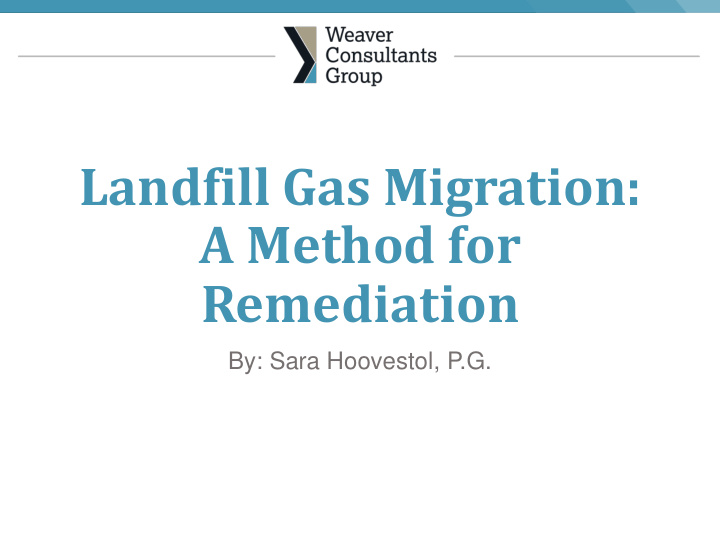



Landfill Gas Migration: A Method for Remediation By: Sara Hoovestol, P.G.
What Are We Going To Cover: ▪ Site Background ▪ Historical Landfill Gas (LFG) Measurements ▪ Investigation and Design of Remediation Method ▪ Construction of Trench ▪ How Did It All Turn Out ▪ Lessons Learned
Site Background
Overview of the Site ▪ Bullets ▪ Bullets ▪ Bullets
Historical LFG Measurements
Historical LFG Measurements Methane Monitoring Results June 2011-October 2013 GW-1R Percent of Percent Lower Methane by Date Explosive Volume Limit (LEL in Air for Methane) 6/20/2011 32.7 654 9/28/2011 26.5 530 12/13/2011 14.5 290 3/5/2012 21.1 422 6/20/2012 21.4 428 10/25/2012 10.1 202 11/27/2012 1.7 34 3/14/2013 16.5 330 6/19/2013 28.7 574 9/10/2013 26.7 534
Investigation and Design of Remediation Method
Investigation ▪ Previously installed passive gas vents are not adequate ▪ Weaver Consultants Group developed a gas sounding method ▪ Gas sounding results were compared to the gas probe boring log ▪ Determined a general correlation between the sounding result interval and an angular gravel/sandstone cobble interval in the boring log
Findings and Design ▪ The results of the investigation indicated LFG gas appeared to be migrating approximately 18 feet below ground surface. ▪ Weaver Consultants Group proposed the installation of a gas cutoff trench ▪ Design Objective: ▪ Induce vacuum at the depth of gas migration
Design Drawing
Construction of Trench
Digging The Trench
Placement of 80-mil HDPE
Pipe Being Placed in Trench
Trench with Gravel
Trench Being Backfilled
Completed Trench
How Did It All Turn Out (The Results)
Recent Monitoring Results Methane Monitoring Results Methane Monitoring Results October 2013-November 2018 June 2011-September 2013 GW-1R GW-1R Percent of Percent Lower Percent of Methane by Percent Date Explosive Limit Lower Volume Methane by (LEL for Date Explosive in Air Volume Methane) Limit (LEL in Air for Methane) 10/15/2013* 5.7 114 3/27/2014 0 0 6/20/2011 32.7 654 6/16/2014 0.1 2 9/23/2014 0 0 9/28/2011 26.5 530 11/4/2014 0 0 12/13/2011 14.5 290 3/26/2015 0 0 6/26/2015 0 0 3/5/2012 21.1 422 9/24/2015 0 0 11/3/2015 0 0 6/20/2012 21.4 428 3/17/2016 0 0 6/9/2016 0 0 10/25/2012 10.1 202 9/23/2016 0 0 11/27/2012 1.7 34 11/15/2016 0 0 3/16/2017 0 0 3/14/2013 16.5 330 6/22/2017 0 0 9/15/2017 0 0 6/19/2013 28.7 574 11/1/2017 0 0 3/14/2018 0 0 9/10/2013 26.7 534 6/20/2018 0 0 9/20/2018 0 0 11/7/2018 0 0
Recent Monitoring Results Methane Monitoring Results Methane Monitoring Results 2016-2018 2016-2018 Trench Vents (near GW-1R) Trench Vents (near GW-1R) Percent of Percent of Percent Lower Percent Lower Vent Methane by Explosive Vent Methane by Explosive Date Date Number Volume Limit (LEL Number Volume Limit (LEL in Air for in Air for Methane) Methane) 1 6.3 126 1 0 0 9/15/2017 2 0 0 3/17/2016 2 0 0 3 0 0 3 0 0 1 0.4 8 1 0.9 18 11/1/2017 2 0 0 6/9/2016 2 0 0 3 0.2 4 3 0 0 1 0 0 1 0 0 3/14/2018 2 0 0 9/23/2016 2 0 0 3 0 0 3 0 0 1 10.9 218 1 0 0 11/15/2016 2 0 0 6/20/2018 2 0 0 3 0 0 3 0 0 1 0.8 16 1 0 0 3/16/2017 2 0 0 9/20/2018 2 0 0 3 0 0 3 0 0 1 4.7 94 1 0 0 6/22/2017 2 0 0 11/7/2018 2 0 0 3 0 0 3 0 0
Lessons Learned
Lessons Learned ▪ Importance of quality boring logs ▪ Do it once ▪ Proper construction quality assurance
Questions? Contact Information: Sara Hoovestol, P.G. shoovestol@wcgrp.com 720-529-0132
Recommend
More recommend